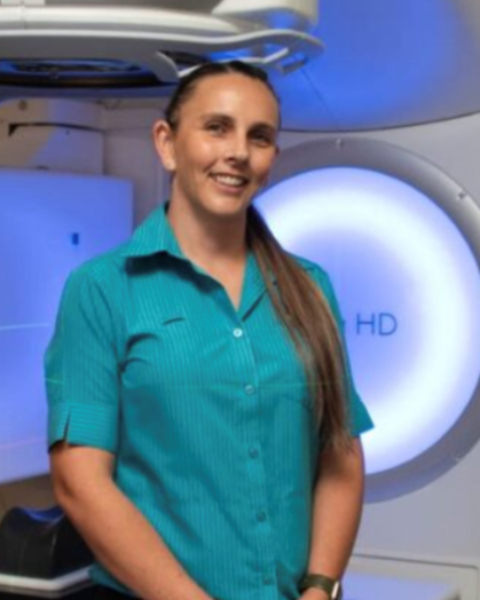PQA 08 - PQA 08 Genitourinary Cancer, Patient Safety, and Nursing/Supportive Care Poster Q&A
3275 - Automated Template-Based Planning and Prostate Stereotactic Body Radiotherapy without Real-Time Seed-Tracking: A Regional Service Experience
Tuesday, October 1, 2024
2:30 PM - 3:45 PM ET
Location: Hall C
Screen: 21

Amie Ross, RT
Mid North Coast Cancer Institute (MNCCI) Coffs Harbour
Coffs Harbour, NSW
Presenter(s)
A. Ross1, A. Karl1, M. Wood1, F. Alshamrani1, L. Chamberlain1, C. Clark1, P. Devlin1, G. Livingston1, D. Panada1, T. Shakespeare1, L. Benjamin1, A. Kovendy1, B. Waller1, S. Armstrong2, M. Hsieh1, S. Behin-Ain2, J. Goodworth1, and S. Greenham1; 1Mid North Coast Cancer Institute, Coffs Harbour, Australia, 2North Coast Cancer Institute, Lismore, Australia
Purpose/Objective(s): To implement an efficient Prostate SABR program into a regional service without real-time seed-tracking capability utilizing automated template-based planning. Materials/
Methods: Our regional service uses multileaf collimator linear accelerators which are not equipped to perform real-time seed-tracking prompting the exploration of alternatives to mitigate the risk of tumour motion during treatment. A protocol was developed using EVIQ Guidelines as well as PACE-B and PACE-C clinical trial constraints. A treatment planning template was developed using treatment planning software with a single 10MV FFF beam to minimise treatment delivery time, minimising the risk of intra-fraction motion. Using scripting 200 plans were calculated and dosimetric criteria exported without therapist intervention. Plans were analysed using ideal, minor, or major violation criterion. A Cone Beam Computer Tomography (CBCT) protocol was developed to optimise image quality; without increasing image acquisition time. An Intra-fraction CBCT protocol was developed for post treatment review to assess possible variation during treatment and patient stability. A Surface Guided Radiation Therapy (SGRT) protocol was developed to assist with monitoring during treatment.
Results: A treatment Planning Template developed using 200 plans achieved clinically acceptable plans over 80% of the time with no intervention. The clinical template met treatment criteria or required only minor changes in 95% of patients. Running the template via script allowed 57% more plans to be assessed for template performance, giving increased confidence that dosimetric results can be consistent without therapist intervention. Treatment delivery quality was assessed using routine Physics Quality Assurance (QA) methods. 30 plans were delivered on an arc check with all plans passing QA with a minimum pass rate of 95% using Gamma Analysis with 2% and 2mm. Treatment delivery time was assessed for 30 plans with an average delivery time of 90 seconds. Use of template-based planning allowed consistent plan quality, improved efficiency, and consistent treatment delivery times. The use of scripting further enhanced efficiency. Data from pre-treatment CBCT’s, Intra-Fraction CBCT and SGRT will allow assessment of patient stability.
Conclusion: An efficient Prostate SABR program can be successfully implemented in a regional service without real-time seed-tracking. Template-based planning allows shorter planning time frames and more consistent treatment plans and treatment delivery times. Script-based planning allowed more plans to be assessed for template performance, increasing confidence that dosimetric results can be consistent without therapist intervention. The use of Intra-Faction CBCT in conjunction with SGRT will allow verification of patient stability during treatment.
Purpose/Objective(s): To implement an efficient Prostate SABR program into a regional service without real-time seed-tracking capability utilizing automated template-based planning. Materials/
Methods: Our regional service uses multileaf collimator linear accelerators which are not equipped to perform real-time seed-tracking prompting the exploration of alternatives to mitigate the risk of tumour motion during treatment. A protocol was developed using EVIQ Guidelines as well as PACE-B and PACE-C clinical trial constraints. A treatment planning template was developed using treatment planning software with a single 10MV FFF beam to minimise treatment delivery time, minimising the risk of intra-fraction motion. Using scripting 200 plans were calculated and dosimetric criteria exported without therapist intervention. Plans were analysed using ideal, minor, or major violation criterion. A Cone Beam Computer Tomography (CBCT) protocol was developed to optimise image quality; without increasing image acquisition time. An Intra-fraction CBCT protocol was developed for post treatment review to assess possible variation during treatment and patient stability. A Surface Guided Radiation Therapy (SGRT) protocol was developed to assist with monitoring during treatment.
Results: A treatment Planning Template developed using 200 plans achieved clinically acceptable plans over 80% of the time with no intervention. The clinical template met treatment criteria or required only minor changes in 95% of patients. Running the template via script allowed 57% more plans to be assessed for template performance, giving increased confidence that dosimetric results can be consistent without therapist intervention. Treatment delivery quality was assessed using routine Physics Quality Assurance (QA) methods. 30 plans were delivered on an arc check with all plans passing QA with a minimum pass rate of 95% using Gamma Analysis with 2% and 2mm. Treatment delivery time was assessed for 30 plans with an average delivery time of 90 seconds. Use of template-based planning allowed consistent plan quality, improved efficiency, and consistent treatment delivery times. The use of scripting further enhanced efficiency. Data from pre-treatment CBCT’s, Intra-Fraction CBCT and SGRT will allow assessment of patient stability.
Conclusion: An efficient Prostate SABR program can be successfully implemented in a regional service without real-time seed-tracking. Template-based planning allows shorter planning time frames and more consistent treatment plans and treatment delivery times. Script-based planning allowed more plans to be assessed for template performance, increasing confidence that dosimetric results can be consistent without therapist intervention. The use of Intra-Faction CBCT in conjunction with SGRT will allow verification of patient stability during treatment.
